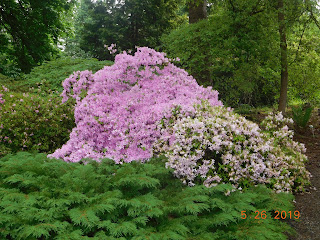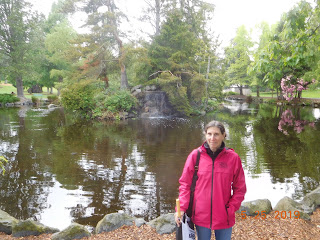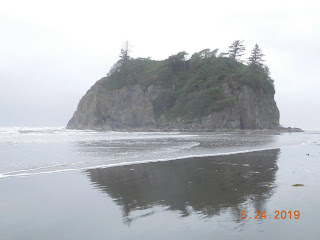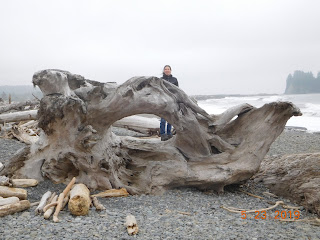Another leisurely morning ending with a trip to Boehm’s Chocolates where we had samples of an international selection of dark chocolates, from Ecuador to Hawaii to Machu Picchu. All were good but we purchased the Hawaii as it contained a higher percentage of cacao. The afternoon, after a stop for boba teas at Sharetea, was spent in Snoqualmie, WA, about 8 miles east of Issaquah and home to Snoqualmie Falls, a powerful and wide waterfall of 268 feet. We began at the top of the falls and the trail leads down to the lower river for a great view of the falls. The falls are part of a hydroelectric plant that was built in 1898 and expanded a few times since then. The plant does not impeded the flow of the river nor effect the water quality or temperature. After the falls, we walked around historic downtown Snoqualmie which did not take very long. The most notable thing about downtown was the main street is lined with back in angular parking. Getting out is easier but getting into a spot on a 2 lane through street requires a lot of cooperation from the traffic.
Day 56, May 27, 2019, Monday. Issaquah, WA (Seattle) (39 miles)
After a leisurely morning, we departed Tacoma for the short drive and a noon check-in at Issaquah Village RV Park (fhu 50 amps), our Seattle Campground located 17 miles east of the city. In the afternoon we headed to the Pike Place Public Market in downtown Seattle. Although we had been there before it was still an amazing adventure. We sampled cheese, chocolate and cherries. We bought 3 different types of dried cherries, Tayberry jam (a cross between a Scottish raspberry and an Aurora blackberry) and after a stop at Le Panier “a very French Bakery” we took home an amandine croissant and a kouign aman aux pommes. We then headed to Seattle Center and the Chihuly Garden and Glass. Prior to entering Chihuly, we walked around the Center which had the Folklife festival going on this Memorial Day. Many international food vendors and craft vendors not to mention a very diverse and interesting crowd. The Chihuly exhibit was larger than Tacoma’s and similar to St. Pete’s but with the added dimension of a display in a conservatory (right next to the Space Needle) and also an outdoor garden which was very well done. Also included in the garden was an Airsteam RV which was converted into the ovens for glass blowing demonstrations. Dinner in the coach followed by our French pastries. The kouign aman was good but did not compare to the Montreal version. The croissant was delicious.
Day 55, May 26, 2019, Sunday. Puyallup, WA (Tacoma)
We began at the Rhododendron Species Botanical Garden in Federal Way, WA. Having seen incredible rhododendron blooms just about everywhere the last several weeks we were expecting a bonanza of colors. However, we discovered the hundreds of different species bloom at different times and that most had already bloomed and were on the decline. It was still a nice relaxing walk through the garden. Adjacent to the Rhododendron Garden was the Pacific Bonsai Museum. A display of 60 bonsai from all over the world in one of only a few gardens dedicated solely to bonsai. The bonsai were incredible and the garden with its raked gravel paths very peaceful. After lunch we stopped at the one and only Almond Rocha factory. No factory tours but a tasting room gift shop. The factory makes 2.5 million pieces a day and ships to 65 countries. No I did not eat quite that many samples but I did have my fill and we did make some purchases. Next we visited the Museum of Glass. Of course there is a museum of glass in the hometown of Dale Chihuly and it even had a Chihuly display. Interestingly, the Chihuly museum in St. Petersburg, FL, has a larger collection of his work. However, outside the museum on a pedestrian bridge known as the “Bridge of Glass” contains many more Chihuly works. The bridge crosses over a freeway and leads to the restored former train Union Station which is now a federal courthouse. The museum had an interesting exhibit by Preston Singletary about the Tlingit People of Southeast Alaska and their theory of creation told in glass with music and sounds to accompany it. A white raven stole the stars, sun and moon which lead to the creation of all the humans and animals. The raven turned black as he is today due to his dirty deed.
We finally departed the Olympic Peninsula and returned to civilization arriving at Washington State Fair RV Park in Puyallup (fhu 50 amp), our base to visit Tacoma. We drove into Tacoma and visited the Tacoma Chinese Reconciliation Park. The park is an attempt to provide a peaceful and tranquil place to acknowledge the awful discrimination against the Chinese immigrants who had been living there for decades. In the 1880's, Tacoma, needing a scapegoat for financially troubling times, kicked out all the Chinese by threats of force and bodily injury which were carried out in some instances. We then visited the Point Defiance Park which had a rose garden, Japanese garden and other gardens plus a “5 mile drive” through the park’s old growth forest with several overlooks at the surrounding waters. One overlook was a view of the Tacoma Narrows Bridge. The present bridge consists of a 1950 replacement for the 1940 four month old bridge that famously was filmed wildly swaying until its collapse. On the way back to the coach we just had to drive by Bob’s Java Jive. A 1927 piece of mimetic architecture - a 25 foot tall and 30 foot wide building in the shape of a coffee pot. Although originally the Coffee Pot Restaurant, it is now a bar and music venue.
Continuing our exploration of Olympic NP, we visited the Hoh Rain Forest in the morning. We hiked the Hall of Mosses Trail and the Spruce Trail. With a winter rainfall of 140 to 170 inches, the mosses and ferns blanket the floor and hang from the firs, spruces, hemlocks, maples and cedars. The competition for space is so intense that the tree seedlings can’t survive among the ferns but thrive when they fall on a previously fallen tree (known as a nurse tree) and take nutrients from the nurse tree until its root can reach the ground. Often times as the nurse tree rots away it leaves gaps in the new tree’s roots. The mosses appear to affect the maples the most by weighing heavily on them causing the maples to bend, sometimes all the way to the ground causing a second root system to form. The Spruce Trail passes along the Hoh River which allows more spacing for the trees. Some trees root too close and the river claims them. In the afternoon we visited Ruby Beach which was covered by clouds. Although plenty of rocks, this beach actually had some sandy parts. We walked the beach but the best part was climbing on the rocks. The weather was cold and then all of the sudden the sun made a little appearance and our photos improved a bit. It warmed up a little but not by too much. On the way back we took a road to view the “Big Tree”. Three miles of pavement gave way to 2 miles of gravel road and some vague hand made signs. No other cars or any sign of civilization was present and we did not know how far we had to go to see the “Big Tree”. Despite Rosemary’s desire to turn back, I continued and shortly thereafter we came upon a sign with an arrow pointed up a hill stating no turnaround after this point. Not wanting to hike the hill, I continued in the car and came upon what appeared to be a really big dead tree. As we got out of the car, we did spot some green growth on the tree billed as the world’s largest red cedar. Fortunately, with no other cars around there was room to turn our car around. The drive back included quite a lot of laughter about the big nearly dead tree.
Day 52, May 23, 2019, Thursday. Forks, WA (54 miles)
We had a late checkout from our campground since we were heading west and the sole road west was closed for maintenance from 9 am to 1 pm. That gave us time to hike the Elwha Dam trail which begins right next to our campground. The dam has been removed in a restoration project allowing the Elwha River to flow naturally again. After lunch we drove to Forks, WA, and checked into the Forks 101 RV Park (fhu 50 amps). We then drove to another part of Olympic NP, Rialto Beach. Although sunny in Forks, in the 20 minutes time it took to get to the coast the sun had disappeared and visibility substantially reduced. The beach is mostly rocks although round and smooth and littered with dead wood, the result of trees growing too close to the water. Although we walked some of the beach, the two jacket weather cut our visit somewhat short.






































































































